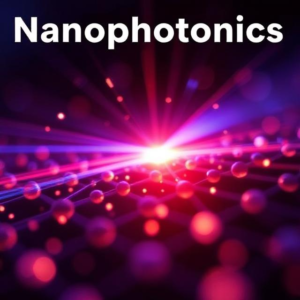Nanophotonics is the study and application of light (photons) at the nanoscale—meaning, it deals with how light behaves when it interacts with objects that are extremely small, typically on the scale of nanometers (one nanometer is one-billionth of a meter). This area of science and technology combines optics (study of light) with nanotechnology (working with very tiny materials).

1. What is Nanophotonics?
Nanophotonics is all about light and how it interacts with very tiny structures—much smaller than the wavelength of visible light. At the nanoscale, materials can behave differently, and light can do things that it doesn’t do in larger-scale materials.
For example, light might behave like a wave or a particle, and it might get trapped in tiny spaces or manipulated in ways that would be impossible with bigger structures.
2. Why is the Nanoscale Important?
On the nanoscale, light can act in very interesting ways because:
- Light waves are usually much larger than the tiny structures at the nanoscale. This means that when light hits a nanomaterial, it can do things like bend, focus, or reflect in strange ways.
- Nanomaterials can also enhance light in certain situations. For example, they might concentrate light into very small spaces or even boost the light intensity.
At this tiny scale, the way light behaves can be very different from what we see with everyday objects.
3. Key Concepts in Nanophotonics
Let’s look at some of the important concepts in nanophotonics:
a. Plasmonics
Plasmonics involves the study of surface plasmons, which are special waves of electrons that move along the surface of metals (like gold or silver) when they interact with light. These waves can be used to control light in ways that allow it to be manipulated at very small scales, which is useful in applications like sensors and high-resolution imaging.
b. Photonic Crystals
A photonic crystal is a material that can control the flow of light like how semiconductors control the flow of electricity. These materials have a periodic structure on the nanoscale that can block or guide light, making them useful for things like laser technology or light-based computing.
c. Metamaterials
Metamaterials are man-made materials that have properties not found in nature. By designing these materials at the nanoscale, scientists can create artificial materials that bend or focus light in specific ways. One exciting example is invisibility cloaks, which can bend light around an object so that it’s hidden from view.
d. Nano-optics
This is the study of how light behaves when it interacts with structures that are smaller than the wavelength of light. For example, scientists can use nanostructures like tiny grooves or holes to control the way light is transmitted, reflected, or absorbed.
4. Applications of Nanophotonics
Nanophotonics is still a relatively new field, but it already has a wide range of potential applications in various industries:
a. Faster Computers and Electronics
One of the most exciting uses of nanophotonics is in optical computing. Today’s computers use electrons to process information, but researchers are working to develop computers that use light (photons) instead. Since light moves faster than electricity, this could lead to much faster and more efficient computers.
b. Improved Solar Cells
Nanophotonics can help make solar panels more efficient by using nanomaterials to capture more sunlight or direct it to the solar cells in a better way. Some nanomaterials can absorb a wider range of light, which can increase the amount of energy produced by solar cells.
c. Advanced Medical Imaging
Nanophotonics can enhance medical technologies like imaging and sensing. For example, by using nanoparticles that interact with light, doctors can get clearer and more detailed images of tissues and organs. These techniques could help detect diseases like cancer much earlier.
d. Better LED Lights and Displays
Nanophotonics can help make LED lights more efficient and displays (like those on phones or TVs) sharper and brighter. Tiny nanostructures can control the way light is emitted or absorbed in these devices, improving their performance.
e. Sensors
Nanophotonic sensors can detect tiny amounts of substances by measuring how light interacts with them. These sensors could be used in applications ranging from environmental monitoring (detecting pollutants) to medical diagnostics (detecting specific molecules in blood or urine).
5. Challenges in Nanophotonics
Although nanophotonics holds a lot of promise, there are also challenges:
- Manufacturing: Creating the tiny structures needed for nanophotonics is difficult and expensive. We need highly precise tools to make nanomaterials.
- Material Limitations: Many materials that work well in nanophotonics are still being developed, and we don’t yet have the perfect materials for every application.
- Energy Efficiency: Some nanophotonic devices require a lot of energy to operate, so improving energy efficiency is an ongoing challenge.
6. Summary
In simple terms, nanophotonics is the study of how light interacts with tiny materials at the nanometer scale. By understanding and controlling these interactions, scientists can develop advanced technologies for faster computers, better solar panels, improved medical imaging, and more efficient sensors.











